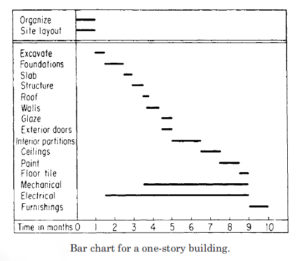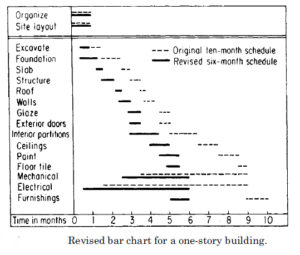
CONSTRUCTION MANAGEMENT
ACE ACADEMY IES ESE HANDWRITTEN CLASSROOM NOTES
ENGINEERING SERVICES GOVT JOBS EXAMINATION NOTES
FREE DOWNLOAD PDF
Construction Management IES ESE Exam Ace Academy Handwritten Notes PDF Free Download
PLEASE NOTE : MOST OF THE PDF’S AVAILABLE IN THE INTERNET WITH THE NAME OF IES ACE ACADEMY NOTES ARE FAKE. FOR THE SAKE OF INCREASING THEIR WEBSITE POPULARITY/TRAFFIC, FEW WEBSITES ARE ALLEGEDLY PROVIDING SOME USELESS MATERIALS WITH THE NAME OF IES ACE ACADEMY NOTES WHICH IN RETURN MIGHT RUIN STUDENT’S VALUABLE MARKS. TO HELP THE STUDENTS WHO ARE WORKING THEIR LEVEL BEST TO CRACK THE RANKS, WE ARE PROVIDING ONLY VERIFIED ACE ACADEMY IES NOTES HERE. BUT HOWEVER THERE MIGHT BE SOME MANUAL ERRORS IN THE CONTENT OF THIS BOOK.

Construction Management IES ESE Exam Ace Academy Handwritten Notes PDF
TOPICS COVERED IN THIS BOOK
- Introduction to project
- Scheduling Tools
- CPM and PERT
- Charts
- Project cost analysis
- Project Crashing
- Resource Allocations
- Depreciation and Inventory Management
- Project Management Concepts
Why planning and scheduling is best performed by the Critical Path Method (CPM)?
It covers some of the history behind its development and relays some thoughts on where the process may be going in the future. The interplay between the theory of mathematics that underlies the methodology and the modifications needed to make the methodology more practical are themes that continue throughout the text. It is hoped that the conclusion drawn by the reader will be that it is the Scheduler who must balance these two ideals, mathematics and engineering, to provide a useful and user friendly tool to the users of CPM in construction management, manufacturing, software design and other users in the world of projects that must be finished on time and within budget.

History of Scheduling Systems
The Critical Path Method (CPM) was developed specifically for the planning of construction. The choice was fortuitous, since construction accounts for more than 10 percent of the annual gross national product. Almost every activity and every person is affected to some degree by new construction or the need for it. Most projects are started well after the need has been established, seeming to follow the whimsy, “If I’d wanted it tomorrow, I’d have asked for it tomorrow.” The construction industry is a heterogeneous mix of companies ranging in size from the large operations to one-person operations. No matter the size, construction companies face similar situations and, to some degree, similar pressures. Many factors, such as weather, unions, accidents, capital demands, and work loads, are either beyond individual control or difficult to control. New problems in project approvals due to increased public awareness include pollution and ecological controls. CPM does not offer clairvoyance, but it does assemble all the information to the project managing team. Initially, CPM spotlighted construction and the contractor. The owner,
architect, engineer, and public agencies involved in a project are like the backer, producer, and director of a Broadway show: Without them, the show cannot go on, and any lack of competence, motivation, or interest on the part of any one of the team members can delay a project. However, the contractor is the performer who ultimately makes or breaks the construction show.

Gantt Charts and Bar Charts
In the mid-nineteenth century, at least one writer discussed a work versus time graphical representation very similar to today’s bar charts, but it remained for Henry L. Gantt and Frederick W. Taylor to popularize their graphical representations of work versus time in the early l910s. Their Gantt charts were the basis for today’s bar graphs, or bar charts. Taylor and Gantt’s work was the first scientific consideration of work scheduling. Although their work was originally aimed at production scheduling, it was readily accepted for planning and recording the progress of construction. Today, the bar graph remains an excellent graphical representation of activity because it is easy to read and understood by all levels of management and supervision.

Comparison of CPM and PERT
The key difference between CPM and PERT is that one identifies activities of finite and reasonably estimated duration while the other identifies events of zero duration separated by “some form of activity” only loosely understood to be performed within a range of possible durations. This range of durations varies from an optimistic estimate (or shortest time until the next event will occur) to a “most likely” estimate to a pessimistic estimate. This dichotomy was understandable since the duration of an activity, relating to a known quantity of work, was fairly capable of estimation; the duration between events, based upon a scope only vaguely understood, was much more a “guestimate.” The theory behind the PERT method was based upon the interplay between these estimates of duration and the statistical likelihood of a project outcome as the actual duration experienced may fluctuate among the three. However, the early computers of the 1950’s and even the 1960’s did not have the necessary speed or memory to fully utilize the theory and the three estimates were usually combined into one (often by separate calculation by hand alongside the computer) using the formula
DUR = (O + 4M + P)/6
where O = Optimistic,
M = Most Likely and
P = Pessimistic.
The important distinction to remember, before considering the newer offshoots of CPM, is that CPM measures performance of defined activities and the durations of defined activities, while PERT measures the reaching of defined events and the passage of time between these events. Another important difference is that CPM durations are of defined events, while PERT durations are of undefined activity between events.
DOWNLOAD LINK : Construction Management IES ESE Ace Academy Handwritten Classroom Notes Free Download PDF
PASSWORD : CivilEnggForAll
OTHER USEFUL LINKS FROM CIVILENGGFORALL
HYDRAULIC MACHINES IES ESE EXAM HANDWRITTEN NOTES : CLICK HERE
RCC ACE ACADEMY IES EXAM NOTES : CLICK HERE
STRENGTH OF MATERIALS ACE ACADEMY IES EXAM NOTES : CLICK HERE
TRANSPORTATION ENGINEERING ACE ACADEMY IES EXAM NOTES : CLICK HERE
HYDROLOGY ACE ACADEMY IES EXAM NOTES : CLICK HERE
IRRIGATION ACE ACADEMY IES EXAM NOTES : CLICK HERE
SURVEYING ACE ACADEMY IES EXAM NOTES : CLICK HERE
MATHS MADE EASY HANDWRITTEN NOTES : CLICK HERE
REASONING AND APTITUDE MADE EASY GATE HANDWRITTEN NOTES : CLICK HERE
OPEN CHANNEL FLOW MADE EASY GATE HANDWRITTEN NOTES : CLICK HERE
ENGINEERING MECHANICS MADE EASY GATE HANDWRITTEN NOTES : CLICK HERE

Leave a Reply